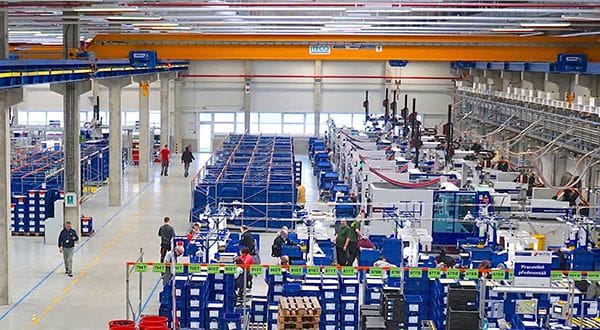
Wittmann Battenfeld’s CMS – Keeping You Informed about the Condition of your Machines
CMS sensor systems for condition monitoring (CMS = condition monitoring system) have been in use in large-scale production plants for many years to minimise profit losses through production downtimes and costly maintenance work.
Application examples are rotary kilns in cement plants, conveying systems in mining, pipe-jacking machines in tunnel construction, power plant turbines or wind power stations. Thanks to recent progress in sensor technology and increasing availability of high-speed data networks, CMS systems are now becoming interesting also for less expensive capital goods such as injection moulding machines. Here, Wittmann Battenfeld has blazed the trail and offers CMS equipment as an optional extra for its injection moulding machines.
In contrast to time-oriented maintenance (preventive maintenance), where machine parts are replaced at fixed intervals regardless of their actual condition, condition monitoring (CM) is based on continuous observation of the parts’ condition (predictive maintenance). The latter approach offers the advantage that replacements depend exclusively on the actual degree of wear and functionality of the parts. The superiority of condition monitoring over preventive maintenance is inherent in the method itself. For any damage occurring in the course of a maintenance interval normally remains undetected and may therefore even lead to a total breakdown, while the problem could often be remedied at little expense if it was detected in time.
The costs for unplanned repairs incurred in this way and the loss of profit caused by the machine standstill are generally higher than the costs of a condition monitoring system. This is all the more important; the more closely the production is linked to a just-in-time supply chain, as is the case, for example, in injection moulding production for automotive suppliers.
Comprehensive CMS package available
At the K 2016, WITTMANN BATTENFELD introduced a condition monitoring system (CMS) which is available as an optional equipment package for injection moulding machines. It accesses the values measured by already existing as well as additional sensors installed for this purpose and passes on these data to a recording system.
The CMS system actually monitors the following:
- in (servo-) hydraulic machines, the drive function of the hydraulic system (vibrations in the pump drive, current consumption, system pressure),
- in (servo-) hydraulic machines, the quality of the oil (temperature, number of particles in the oil and water content), in all-electric machines, the quality of the gear oil,
- the “climate” inside the electric cabinet (temperature, moisture, possible smoke formation),
- the capacity of cooling water and air supply (flow quantity, pressure, temperature),
- the mechanical parameters of the clamping unit (pressures in the pads of MacroPower machines, vibrations and torques in servo-electric drives),
- the mechanical parameters of the plasticising/injection unit (vibration, plasticising torque, screw stroke, closing behaviour of the check valve). One cause of vibration may be a loose screw in the screw coupling which, if it remains unnoticed, may lead to major consequential damage.
Condition data processing on three levels
- Measurement data collection and display on the machine
The data (temperatures, moisture, signals from the smoke detector inside the electric cabinet) are collected on the machine partly cycle-synchronously and partly dependent on time, and subsequently transmitted to the CMS computer for evaluation. On the machine, the current condition data are displayed compactly on an overview page of the machine’s B8 control system. Deviations from pre-set reference values (temperature ranges, air pressure, and smoke detector signals) are visualised by green/red traffic light indicators.
- Data analysis and processing on the CMS host computer
The heart of the CMS system is the CMS computer. It is part of a production control system. It communicates with the injection moulding machines and draws the measurement data, collects and saves them for possible later backtracking. The CMS software processes the measurement data into trend-tracking models.
A CMS control station can monitor up to 50 machines simultaneously and pass on advance warnings to maintenance staff by email.
- Data evaluation and condition analysis
Evaluation of the data is based on generally recognised quality standards, such as the NAS (National Aerospace Standard) oil quality assessment1638 or the oil purity rating according to ISO-4406. Empirical limit values are used for judging air and oil pressure values, temperatures or the closing behaviour of the check valve. In addition, the vibrations of components exposed to wear are measured by vibration sensors and evaluated by analysis algorithms.
Besides current status information, the CMS software also delivers trends indicating changes in functional values. These provide the basis for decision-making by maintenance staff. Should no sufficiently qualified or experienced personnel be available on site for correct interpretation of this decision-making tool, it is also possible to outsource the interpretation of the data to a WITTMANN BATTENFELD service centre via online networking and have the necessary maintenance work initiated from there. This service can be supplied by the WITTMANN BATTENFELD service organisation.
Summary
Condition-oriented machine maintenance offers better failure protection than servicing in fixed, regular intervals or a preventive maintenance concept since, due to lack of information, malfunctions developing between maintenance sessions (loose screws, gradual failure of bearings) with a risk of sudden total breakdown are very hard to detect. This is why a CMS system is a useful contribution to improving failure protection of production processes, primarily and in particular for just-in-time production chains. The cost of implementing a condition monitoring system is already compensated for by preventing only a few days of production standstill.
Wittmann Battenfeld
+44 (0)1933 275777
Website
Email





